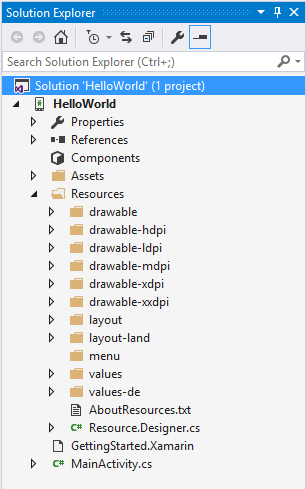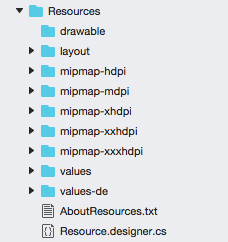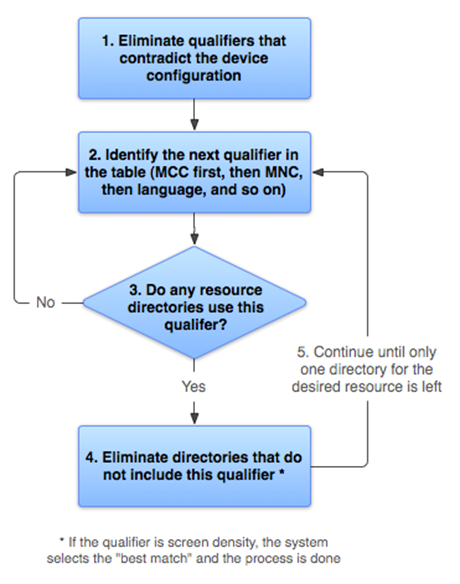Alternate Resources
Alternate resources are those resources that target a specific device or run-time configuration such as the current language, particular screen size, or pixel density. If Android can match a resource that is more specific for a particular device or configuration than the default resource, then that resource will be used instead. If it does not find an alternate resource that matches the current configuration, then the default resources will be loaded. How Android decides what resources will be used by an application will be covered in more detail below, in the section Resource Location
Alternate resources are organized as a sub-directory inside the Resources folder according to the resource type, just like default resources. The name of the alternate resource subdirectory is in the form: ResourceType-Qualifier
Qualifier is a name that identifies a specific device configuration. There may be more than one qualifier in a name, each of them separated by a dash. For example, the screenshot below shows a simple project that has alternate resources for various configurations such as locale, screen density, screen size, and orientation:
The following rules apply when adding qualifiers to a resource type:
There may be more than one qualifier, with each qualifier separated by a dash.
The qualifiers maybe specified only once.
Qualifiers must be in the order they appear in the table below.
The possible qualifiers are listed below for reference:
MCC and MNC – The mobile country code (MCC) and optionally the mobile network code (MNC). The SIM card will provide the MCC, while the network the device is connected to will provide the MNC. Although it is possible to target locales using the mobile country code, the recommend approach is to use the Language qualifier specified below. For example, to target resources to Germany, the qualifier would be
mcc262. To target resources for T-Mobile in the U.S., the qualifier ismcc310-mnc026. For a complete list of mobile country codes and mobile network codes see http://mcc-mnc.com/.Language – The two-letter ISO 639-1 language code and optionally followed by the two-letter ISO-3166-alpha-2 region code. If both qualifiers are provided, then they are separated by an
-r. For example, to target French-speaking locales then the qualifier offris used. To target French-Canadian locales, thefr-rCAwould be used. For a complete list of language codes and region codes, see Codes for the Representation of Names Of Languages and Country names and code elements.Smallest Width – Specifies the smallest screen width the application is meant to execute on. Covered in more detail in Creating Resources for Varying Screens. Available in API level 13 (Android 3.2) and above. For example, the qualifier
sw320dpis used to target devices whose height and width is at least 320dp.Available Width – The minimum width of the screen in the format wNdp, where N is the width in density independent pixels. This value may change as the user rotates the device. Covered in more detail in Creating Resources for Varying Screens. Available in API level 13 (Android 3.2) and above. Example: the qualifier w720dp is used to target devices that have a width of least 720dp.
Available Height – The minimum height of the screen in the format hNdp, where N is the height in dp. This value may change as the user rotates the device. Covered in more detail in Creating Resources for Varying Screens. Available in API level 13 (Android 3.2) and above. For example, the qualifier h720dp is used to target devices that have a height of least 720dp
Screen Size – This qualifier is a generalization of the screen size that these resources are for. It is covered in more detail in Creating Resources for Varying Screens. Possible values are
small,normal,large, andxlarge. Added in API level 9 (Android 2.3/Android 2.3.1/Android 2.3.2)Screen Aspect – This is based on the aspect ratio, not the screen orientation. A long screen is wider. Added in API level 4 (Android 1.6). Possible values are long and notlong.
Screen Orientation – Portrait or landscape screen orientation. This can change during the lifetime of an application. Possible values are
portandland.Dock Mode – For devices in a car dock or a desk dock. Added in API level 8 (Android 2.2.x). Possible values are
caranddesk.Night Mode – Whether or not the application is running at night or in the day. This may change during the lifetime of an application and is meant to give developers an opportunity to use darker versions of an interface at night. Added in API level 8 (Android 2.2.x). Possible values are
nightandnotnight.Screen Pixel Density (dpi) – The number of pixels in a given area on the physical screen. Typically expressed as dots per inch (dpi). Possible values are:
ldpi– Low density screens.mdpi– Medium density screenshdpi– High density screensxhdpi– Extra high density screensnodpi– Resources that are not to be scaledtvdpi– Introduced in API level 13 (Android 3.2) for screens between mdpi and hdpi.
Touchscreen Type – Specifies the type of touchscreen a device may have. Possible values are
notouch(no touch screen),stylus(a resistive touchscreen suitable for a stylus), andfinger(a touchscreen).Keyboard Availability – Specifies what kind of keyboard is available. This may change during the lifetime of an application – for example when a user opens a hardware keyboard. Possible values are:
keysexposed– The device has a keyboard available. If there is no software keyboard enabled, then this is only used when the hardware keyboard is opened.keyshidden– The device does have a hardware keyboard but it is hidden and no software keyboard is enabled.keyssoft– the device has a software keyboard enabled.
Primary Text Input Method – Use to specify what kinds of hardware keys are available for input. Possible values are:
nokeys– There are no hardware keys for input.qwerty– There is a qwerty keyboard available.12key– There is a 12-key hardware keyboard
Navigation Key Availability – For when 5-way or d-pad (directional-pad) navigation is available. This can change during the lifetime of your application. Possible values are:
navexposed– the navigational keys are available to the usernavhidden– the navigational keys are not available.
Primary Non-Touch Navigation Method – The kind of navigation available on the device. Possible values are:
nonav– the only navigation facility available is the touch screendpad– a d-pad (directional-pad) is available for navigationtrackball– the device has a trackball for navigationwheel– the uncommon scenario where there are one or more directional wheels available
Platform Version (API level) – The API level supported by the device in the format vN, where N is the API level that is being targeted. For example, v11 will target an API level 11 (Android 3.0) device.
For more complete information about resource qualifiers see Providing Resources on the Android Developers website.
How Android Determines What Resources to Use
It is very possible and likely that an Android application will contain many resources. It is important to understand how Android will select the resources for an application when it runs on a device.
Android determines the resources base by iterating over the following test of rules:
Eliminate contradictory qualifiers – for example, if the device orientation is portrait, then all landscape resource directories will be rejected.
Ignore qualifiers not supported – Not all qualifiers are available to all API levels. If a resource directory contains a qualifier that is not supported by the device, then that resource directory will be ignored.
Identify the next highest priority qualifier – referring to the table above select the next highest priority qualifier (from top to bottom).
Keep any resource directories for qualifier – if there are any resource directories that match the qualifier to the table above select the next highest priority qualifier (from top to bottom).
These rules are also illustrated in the following flowchart:
When the system is looking for density-specific resources and cannot find them, it will attempt to locate other density specific resources and scale them. Android may not necessarily use the default resources. For example, when looking for a low-density resource and it is not available, Android may select high-density version of the resource over the default or medium-density resources. It does this because the high-density resource can be scaled down by a factor of 0.5, which will result in fewer visibility issues than scaling down a medium-density resource which would require a factor of 0.75.
As an example, consider an application that has the following drawable resource directories:
drawable
drawable-en
drawable-fr-rCA
drawable-en-port
drawable-en-notouch-12key
drawable-en-port-ldpi
drawable-port-ldpi
drawable-port-notouch-12key
And now the application is run on a device with the following configuration:
- Locale – en-GB
- Orientation – port
- Screen density – hdpi
- Touchscreen type – notouch
- Primary input method – 12key
To begin with, the French resources are eliminated as they conflict
with the locale of en-GB, leaving us with:
drawable
drawable-en
drawable-en-port
drawable-en-notouch-12key
drawable-en-port-ldpi
drawable-port-ldpi
drawable-port-notouch-12key
Next, the first qualifier is selected from the qualifiers table above: MCC and MNC. There are no resource directories that contain this qualifier so the MCC/MNC code is ignored.
The next qualifier is selected, which is Language. There are resources that
match the language code. All resource directories that do not match the language
code of en are rejected, so that the list of resources is now:
drawable-en-port
drawable-en-notouch-12key
drawable-en-port-ldpi
The next qualifier that is present is for screen orientation, so all resource
directories that do not match the screen orientation of port are eliminated:
drawable-en-port
drawable-en-port-ldpi
Next is the qualifier for screen density, ldpi, which results in the exclusion of one more resource directory:
drawable-en-port-ldpi
As a result of this process, Android will use the drawable resources in the
resource directory drawable-en-port-ldpi for the device.
Note
The screen size qualifiers provide one exception to this selection process. It is possible for Android to select resources that are designed for a smaller screen than what the current device provides. For example, a large screen device may use the resources provide for a normal sized screen. However the reverse of this is not true: the same large screen device will not use the resources provided for an xlarge screen. If Android cannot find a resource set that matches a given screen size, the application will crash.


